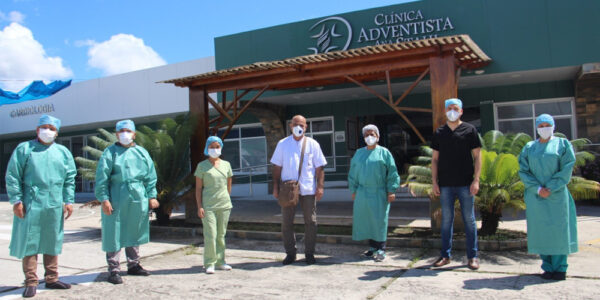Few places capture the modern American imagination like Peru — land of the Incas and the mesmerizing Machu Picchu; the towering Andes mountains with peaks above 22,000 feet; and the mysterious Amazon jungle, which still holds undiscovered indigenous peoples, plants, and animals.
Tragedy has struck in a corner of this paradise, centered in the city of Iquitos, the largest city in the world with no road access. You wouldn’t think that a contagious virus like COVID-19 would wreak havoc in such an isolated place, but it has arrived with a vengeance.
In the midst of this calamity is Clínica Adventista Ana Stahl. Founded by the courageous mission pioneers Fernando and Ana Stahl, the hospital (known as “la Clínica,” since only government facilities can be called hospitals) has cared for this community with more than half a million population for 93 years. Though modest in size, la Clínica provides the best health-care services in the region and is well known for its quality and the dedication and compassion of its medical professionals.
A National and Local Emergency
Enter COVID-19, and the tranquility of this idyllic setting is shattered. Calling a national emergency, the president of Peru, Martín Vizcarra, enacted a nationwide curfew and stay-at-home policy on March 15, 2020, and all commercial flights in, out, and within the country were immediately canceled. Thousands of Americans were stranded. By April 9, about 6,800 U.S. citizens had been evacuated.1 The U.S. Embassy in Peru, however, has posted additional evacuation flights, including one scheduled for May 27.2
The virus runs rampant through the poor and crowded shanty towns of Iquitos, which encircle the historic center. Patients overwhelm government hospitals, where medicine and oxygen are in short supply, and dozens die each day. Graciela Meza, executive director of the regional health office, claims that most victims have died from a lack of oxygen; 90 percent have died from a lack of medical supplies.3
Lines of people come to the government hospital seeking care, yet often end up on cots lining the courtyards and hallways. One government doctor estimates that 80 percent of the health-care workers in the region have COVID-19, and dozens of doctors and nurses have died.4 Piles of body bags fill up morgues, yet many people die at home and are quickly buried due to the hot and humid climate.
Struggling to Keep Services
Doing its best to serve the community, la Clínica struggled to provide services. Just as in the government facilities, employees of the Adventist hospital were being infected. By the end of April, 55 percent of the staff were confirmed to have COVID-19 or had COVID-like symptoms.5 Sadly, Elard Calli, the radiologist at la Clínica, passed away from COVID-19 on May 9.
The nurses and doctors still able to work were so few that on April 29, the administration decided to close la Clínica. Milka Brañez, the hospital’s director, wrote, “When we closed la Clínica, I was sick, and I cried bitterly. I felt that I had failed. How could we close at such a critical time for the region? But God has shown me that it was the best in those circumstances.” Continuing, Brañez said, “We are planning how to reopen some services such as drug care for chronic patients. The viral load is still very high in Iquitos. Since our employees are not fully cured and are still contagious, we must be very careful. I am strong in the Lord, and I am not afraid of the future, because God is in control. And we will rise again to help our neighbor who so badly needs us.”
In an encouraging development, the first four staff members to become infected were officially discharged from la Clínica on Monday, May 18, and are confirmed to be well enough to return home. Plans are being made to open a few services to the community again, and the first public services for pharmacy, laboratory, and imaging began on May 26.
Support from Abroad
To help protect employees at la Clínica, the Adventist hospitals in Colorado, United States, have raised more than US$40,000 for personal protective equipment (PPE). Plans are underway to ship additional supplies in partnership with AdventHealth’s Global Mission program based in Central Florida, with Shawnee Mission Medical Center in Kansas City, and with ADRA International. With no income for a month, however, la Clínica’s resources are severely strained, and the institution will need additional support to endure the remainder of the pandemic crisis.
“We thank God and the entire team at our beloved clinic for the care and love that they provide,” Brañez wrote a few days later. “We are going through very hard times in this pandemic. We have lost family, friends, and coworkers, but let’s never forget that God is in control.”
In the United States, we continue to admire the strength and courage of Brañez and her team in this crisis and pray that they will receive the support needed to continue their mission to extend the healing ministry of Christ in the Amazon Basin of Peru.
_________________________
1. “U.S. Government Evacuation Flights from Peru Will Soon Be Phased Out,” The Washington Post, April 9, 2020.
2. U.S. Embassy in Peru, COVID-19 Information, updated May 19, 2020.
3. “We Are Living in a Catastrophe: Peru’s Jungle Capital Choking for Breath as COVID-19 Hits,” The Guardian, May 19, 2020.
4. “Peruvian Hospitals Hit by Double Crises of COVID-19 and Dengue Fever,” France 24, The Observers, May 12, 2020.
5. “Situational Diagnosis of the Health Status for the COVID-19 Pandemic,” Clínica Adventista Ana Stahl, May 6, 2020.



